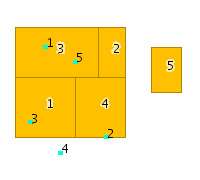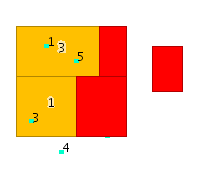- 1. Introduction
- 2. Commands
- 3. Steps to create and validate a topology model
- 4. Subtypes
- 5. Tolerance
- 6. Topology Rules
- 6.1. Summary of rules
- 6.2. Summary of rules in a single layer
- 6.3. Summary of rules between two layers
- 6.4. Point rules. Examples
- 6.5. Point + Point rules. Examples
- 6.6. Point +Line rules. Examples
- 6.7. Point +Polygon rules. Examples
- 6.8. Line rules. Examples
- 6.9. Line + Line rules. Examples
- 6.10. Line + Polygon rules. Examples
- 6.11. Polygon rules. Examples
- 6.12. Polygon + Point rules. Examples
- 6.13. Polygon + Line rules. Examples
- 6.14. Polygon + Polygon rules. Examples
Jaspa implements a rule-based topology based on restrictions. The topological model is two-dimensional.
A topological model consists of layers, and rules to be met by layers. To add and remove those elements is necessary to use Section 2, “Commands”. The order to use the commands can be found in Section 3, “Steps to create and validate a topology model”.
Topological rules can be applied to a subselection of a layer rather than the full layer. Refer to Section 4, “Subtypes” for further information.
The rules can be applied to a single layer (e.g. "Must be valid", "Must not be duplicated"), or between two layers (e.g. "Must be coincident with ","Must be inside"). Section 6, “Topology Rules” includes a description and examples of all Jaspa topological rules.
In this version Jaspa incorporates an experimental cluster tolerance. This is set by the SNAP parameter, it should not be used to prevent geometric errors. By default it is disabled (SNAP false).
Very large layers can cause an out of memory exception. This issue can be solved by setting the TRANSACTION parameter to false. See Section 3.10, “Change the transaction mode” for further information.
SELECT COMMAND(' ');
//TOPOLOGY COMMANDS: CREATE TOPOLOGY toponame DROP TOPOLOGY toponame DROP TOPOLOGY FULL //Layer ADD LAYER schema.name TO toponame ADD LAYER schema.name TO toponame TOLERANCE toleranceUnits ADD LAYER schema.name TO toponame [TOLERANCE toleranceUnits] [SNAP True / False] REMOVE LAYER schema.name FROM toponame ALTER LAYER layername ON toponame [TOLERANCE tolerance] [SNAP true/false] //Rules ADD RULE rulename TO toponame USING table1,table2 [TOLERANCE tolerance] [ATTREXP12 atrexp] REMOVE RULE rulenumber FROM toponame //Validate VALIDATE RULE numberRule ON toponame [FULL | UPDATE] VALIDATE TOPOLOGY toponame [FULL | UPDATE] VALIDATE LAYER layer ON toponame [FULL | UPDATE] VALIDATE LAYER layer [FULL | UPDATE] //Show SHOW TOPOLOGIES SHOW LAYERS ON toponame SHOW RULES ON toponame SHOW RULE number ON toponame //Transaction SET TOPOLOGY_TRANSACTION [TRUE | FALSE <password>];
Example
SELECT command ('create topology t1');
SELECT command ('ADD layer viarialin TO t1 tolerance 0.01');
//Default tolerance 0.001
SELECT command ('ADD layer viariapol TO t1');
--snapping rules
SELECT command ('ADD RULE mbs TO t1 using viarialin');
SELECT command ('ADD RULE mbs TO t1 using viariapol');
SELECT command ('ADD RULE mbsw TO t1 using viarialin,viariapol');
SELECT command ('ADD RULE mbsw TO t1 using viariapol,viarialin');
--other rules
SELECT command ('ADD RULE mnhd TO t1 using viarialin searchwindow 10');
SELECT command ('ADD RULE mbcbbol TO t1 using viarialin,viariapol
attrexp1 {[TABLE1].componen1d like ''B%''}');
SELECT command ('ADD RULE mno TO t1 using viariapol');The process to build a Jaspa topological model constist on creating the model first, second add layers to the model, third add the rules to be satisfied by the layers, and finally validate some rules, some layers or the whole topological model.
With the SHOW commands you can display the rules and layers of a topological model, or obtain information about the topological models of a database.
Finally, with the REMOVE commands, you can delete rules, layers, a full topological model or even all topological models.
SELECT COMMAND ('CREATE TOPOLOGY <topologyModelName>');
select command('create topology topo1')
Result:
"The layers metadata table for the topology topo1 have been created" Jaspa automatically creates the topo schema in the database (if it still does not exist), and two metadata tables in that schema:
layers_<topoName>
rules_topoName
The table layers_<topoName> stores information about the tables that are part of a topological model.
| Field | Type |
|---|---|
| schema_name | character varying |
| table_name | character varying |
| geom_column_name | character varying |
| tolerance | double precision |
| rank | integer |
The rank column at this version indicates whether to apply layer adjustment or not (values 0 or 1). By default, the system does not apply tolerance adjustment. In future releases this column will mark the hierarchy level for layers adjustment.
The table rules_<topoName> stores information about the rules that are part of a topological model.
| Field | Type |
|---|---|
| gid | serial |
| rule | character varying |
| schema1_name | character varying |
| table1_name | character varying |
| geom_column1_name | character varying |
| schema2_name | character varying |
| table2_name | character varying |
| geom_column2_name | character varying |
| tolerance | double precision |
| searchwindow | double precision |
| lastupdate1 | integer |
| lastupdate2 | integer |
| notvalid | integer |
| attrexp1 | character varying |
| attrexp12 | character varying |
SELECT COMMAND ('ADD LAYER <layerSchema>.<layerName1> TO <topologyModelName>');
select command('add layer public.l1 TO topo1');
Result:
"The layer public.l1.geom has been added to the topology topo1"When you add a table to a topology it happens 3 things:
The metadata table layers_<topoName> is updated.
A temporal table <layerName>_topotmp is added for each layer added to the topological model.
A topotime field is added to each layer added to the topological model.
The SQL sentence to add a rule in which participates a single layer is:
SELECT COMMAND ('ADD RULE <ruleShortName> TO <topologyModelName> USING <layerSchema>.<layerName1>');
If the topological rule uses two layers, the SQL sentence is:
SELECT COMMAND ('ADD RULE <ruleShortName> TO <topologyModelName> USING <layerSchema>.<layerName1>,<layerSchema>.<layerName2>');
select command('add rule mbsp TO topo1 using l1');
Result:
"GID=1 NAME=mbsp TABLE1=public.l1.geom TOLERANCE=0.0010 SEARCHWINDOW=0.1 ERRORS=0 ATTREXP1=null ATTREXP12=null
| The topology rule has been added"Internally Jaspa updates the metadata table rules_<topoName>.
There are four ways of validating a topology
Validate a rule:
SELECT COMMAND ('VALIDATE RULE <numberRule> ON <topologyModelName> [FULL | UPDATE]');
Select command('validate rule 1 ON topo1'); --Result: The rule 1 in the topology topo1 has been validated. Errors [Before:0 After validating:1]Validate fully a topological model
SELECT COMMAND ('VALIDATE TOPOLOGY <topologyModelName>');
SELECT COMMAND('validate topology topo1'); --Result: The topology topo1 has been validated.Validate a layer of a specific topological model
SELECT COMMAND ('VALIDATE LAYER <layerName> ON <topologyModelName> [FULL/UPDATE]');
SELECT COMMAND('validate layer l1 ON topo1'); --Result: The topology topo1 has been validated.Validate a layer in any topological model
SELECT COMMAND ('VALIDATE LAYER <layerName> [FULL/UPDATE]');
SELECT COMMAND('validate layer l1 FULL'); --Result: The layer public.l1.geom has been validated.
Jaspa internally:
Updates the metadata table rules_<topoName>.
If a rule is validated for the first time, it creates an error table in the topo schema and inserts errors. The name of the error table is topo.r_<serialRuleNumber><topoName>_<LayerName1>_<RuleShortName>_<LayerName2>.
![[Warning]](images/warning.png) | |
Metadata tables (rules_<topoName>, layers_<topoName>), temporal tables (<layerName>_topotmp) or the temporal field topotime must not be updated manually or deleted to ensure proper operation of Jaspa topology. |
SELECT COMMAND ('SHOW TOPOLOGIES')
SELECT COMMAND ('SHOW TOPOLOGIES');
--Result:
t1 |SELECT COMMAND ('SHOW LAYERS ON toponame')
SELECT COMMAND ('SHOW LAYERS ON topo1');
--Result:
public.l1.geom | 0.0010 | SHOW RULES ON toponame
SELECT COMMAND ('SHOW RULES ON topo1');
--Result:
GID=1 NAME=mbsp TABLE1=public.l1.geom TOLERANCE=0.0010 SEARCHWINDOW=0.1 ERRORS=1 ATTREXP1=null ATTREXP12=null |
SHOW RULE number IN toponame
SELECT COMMAND ('SHOW LAYERS ON topo1');
--Result:
public.l1.geom | 0.0010 | SELECT COMMAND ('REMOVE RULE <rulenumber> FROM <topologyModelName>')
SELECT COMMAND ('REMOVE RULE 1 FROM topo1');
--Result:
The topology rule 1 and its asociated geometry error table has been deletedSELECT COMMAND ('REMOVE LAYER <layerSchema>.<layerName1> FROM <topologyModelName>')
SELECT COMMAND ('REMOVE LAYER l1 FROM topo1');
--Result:
The layer 'public.l1.geom' has been removed from the topology t1ALTER LAYER layername ON toponame [TOLERANCE tolerance] [SNAP true/false]
This command is useful to disable or enable cluster tolerance of a rule. It can also change the tolerance, but this Jaspa version only allows switching to smaller tolerances for new geometries.
Jaspa offers the possibility of eliminating all topological models or one in particular
Elimate every topological model
SELECT COMMAND ('DROP TOPOLOGY FULL');
SELECT COMMAND ('DROP TOPOLOGY FULL'); --Result: The topology metadata structure has been deleted. Use CREATE TOPOLOGY in order to create it again.Eliminate a particular topological model
SELECT COMMAND ('DROP TOPOLOGY <topologyModelName>');
SELECT COMMAND ('DROP TOPOLOGY topo1'); --Result: The topology metadata tables for the topology t1 have been deleted
By default the transaction mode is set to true. If the layers contain a lot of topological errors can cause an out of memory exception. This can be avoided setting the transaction mode to false. If the transaction mode is set to false, the password must also be indicated.
Set transaction mode to FALSE
SELECT COMMAND ('SET TOPOLOGY_TRANSACTION false <password>');
SELECT COMMAND ('SET TOPOLOGY_TRANSACTION false mypassword'); --Result: command ------------------------------------------------- Topology transaction mode has been set to false (1 row)Set transaction mode to TRUE
SELECT COMMAND ('SET TOPOLOGY_TRANSACTION true');
SELECT COMMAND ('SET TOPOLOGY_TRANSACTION true'); --Result: command ------------------------------------------------ Topology transaction mode has been set to true (1 row)
Jaspa allows the use of sub-selections in the application of topological rules. This can be done using the sub-selection parameter (ATTREXP12) when a rule is added.
If the subselection is appliable only to the first layer in a rule, the parameter ATTREP1 must be used.
If the subselection is appliable only to the second layer in a rule or to a combination of the first and second layer, the parameter ATTREP12 must be used.
Let's illustrate this with some examples.
Imagine you want to check that polygons contain one point, but this requirement is only applicable to part of the layer. The rule to use is [Polygon] must contain one [Point].
 |
table_a
| Gid | Type | Geom |
|---|---|---|
| 1 | a1 | POLYGON((-2 5,-2 9,2 9,2 9,2 5,2 5,-2 5)) |
| 2 | a2 | POLYGON((3.5 9,3.5 12.3,5.3 12.3,5.3 9,3.5 9)) |
| 3 | a3 | POLYGON((-2 9,-2 12.3,3.5 12.3,3.5 9,-2 9)) |
| 4 | a4 | POLYGON((2 5,2 9,5.3 9,5.3 5,2 5)) |
| 5 | b | POLYGON((7 8,7 11,9 11,9 8,7 8)) |
table_b
| Gid | Type | Geom |
|---|---|---|
| 1 | 1 | POINT(0 11) |
| 2 | 2 | POINT(4 5) |
| 3 | 3 | POINT(-1 6) |
| 4 | 4 | POINT(1 4) |
| 5 | 5 | POINT(2 10) |
Create the tables and populate date into them:
CREATE TABLE table_a(gid serial PRIMARY KEY,type VARCHAR);
SELECT AddGeometryColumn ('table_a','geom',-1,'POLYGON',2);
INSERT INTO table_a(type ,geom) VALUES ('a1',ST_GeomfromText('POLYGON((-2 5,-2 9,2 9,2 9,2 5,2 5,-2 5))'));
INSERT INTO table_a(type ,geom) VALUES ('a2',ST_GeomfromText('POLYGON((3.5 9,3.5 12.3,5.3 12.3,5.3 9,3.5 9))'));
INSERT INTO table_a(type ,geom) VALUES ('a3',ST_GeomfromText('POLYGON((-2 9,-2 12.3,3.5 12.3,3.5 9,-2 9))'));
INSERT INTO table_a(type ,geom) VALUES ('a4',ST_GeomfromText('POLYGON((2 5,2 9,5.3 9,5.3 5,2 5))'));
INSERT INTO table_a(type ,geom) VALUES ('b',ST_GeomfromText('POLYGON((7 8,7 11,9 11,9 8,7 8))'));
CREATE TABLE table_b(gid serial PRIMARY KEY, type int);
SELECT AddGeometryColumn ('table_b','geom',-1,'POINT',2);
INSERT INTO table_b(type ,geom) VALUES (1,ST_GeomfromText('POINT(0 11)'));
INSERT INTO table_b(type ,geom) VALUES (2,ST_GeomfromText('POINT(4 5)'));
INSERT INTO table_b(type ,geom) VALUES (3,ST_GeomfromText('POINT(-1 6)'));
INSERT INTO table_b(type ,geom) VALUES (4,ST_GeomfromText('POINT(1 4)'));
INSERT INTO table_b(type ,geom) VALUES (5,ST_GeomfromText('POINT(2 10)'));Create the topology set and add the geometry tables to it:
SELECT COMMAND ('create topology t1');
SELECT COMMAND('ADD layer table_a TO t1');
SELECT COMMAND('ADD layer table_b TO t1');Polygons whose type is like a, must contain one point. The rule to use is [Polygon] must contain one [Point]. In this case, as the restriction only applies to first layer the sub-selection parameter to use is ATTREP1.
 | 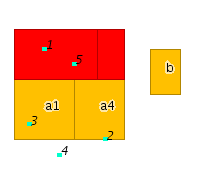 |
Add the rule:
SELECT COMMAND('ADD RULE mcop TO t1 using table_a,table_b
attrexp1 {[TABLE1].type like ''a%''}');Validate
SELECT COMMAND ('VALIDATE RULE 1 on t1');Polygons must contain one point whose type is lower than 3
 | 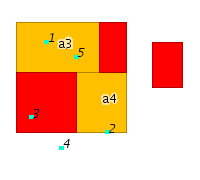 |
Add the rule:
SELECT COMMAND('ADD RULE mcop TO t1 using table_a,table_b
attrexp12 {[TABLE2].type < 3}');Polygons whose type is like a must contain one point whose type is lower than 3
 | 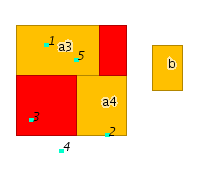 |
Add the rule:
SELECT COMMAND('ADD RULE mcop TO t1 using table_a,table_b
attrexp1 {[TABLE1].type like ''a%''}
attrexp12 {[TABLE2].type < 3}');The cluster tolerence is the minimum distance between coordinates to be considered identical.
If two lines are at a distance of 5 maps units, and the tolerance is set to 10 map units, the vatidation process will consider that the lines are coincident.
Cluster tolerance should be set according to the layer accuracy. It is set with the tolerance parameter when a layer is added to the topology model. ADD LAYER schema.name TO toponame [TOLERANCE toleranceUnits] [SNAP True / False]
If this tolerance is active (Snap True) vertices or edges are snapped to become coincident. If it not specified, the default value 0.001 map units is used.
The cluster tolerance is also used in the rules with tolerance _wt. (See next section).
This parameter is stored in the metadata table layers_<topoName>.
ADD layer <layerName> to <topologyName> tolerance 0.01
Default value 0.001:
ADD layer <layerName> to <topologyName>
Some rules use a snapping tolerance, their name finish with the "_WT" suffix. For instance: Must be disjoint with tolerance (mbd_wt).
SELECT command('ADD RULE mbd_wt TO t1 using l16 tolerance 0.1');If the user does not indicate the tolerance parameter, the layer tolerance is used.
SELECT command('ADD RULE mbd_wt ON t1 using l16');The following example applies the rule "must be disjoint with tolerance" (mbd_wt). We can see that the points on the lower left corner 1 and 3, are disjoint. But if we consider the cluster tolerance they should be considered as coincident and so are marked as errors. Note that the multipoint 3 is composed by two points, and both are marked as errors.
| 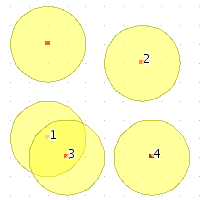  |  |
This parameter is used for the rule must not have dangles. It is used to indicate the maximum distance to search a geometry near to the dangle.
SELECT command('ADD RULE mnhd TO t1 using <layer> searchwindwow 10');If the search window parameter is not specified, it uses as default value 100 times the layer tolerance.
SELECT command('ADD RULE mnhd TO t1 using <layer>');The error layer has a distance field that indicates the distance to the nearest geometry (If there is not a geometry within the search window, it indicates the parameter search window). The gid of the nearest geometry is indicated in the field geomgid2.
| SearchWindow = 10 |  |
| ||||||||||||||||||||
| SearchWindow = 0.1 |  |
|
This section presents a comprehensive list of the available topology rules.
| Geometry | Alias | Rule |
|---|---|---|
Point | mbsp | Must be single Part |
mbd | Must be disjoint | |
mbd_wt | Must be disjoint with tolerance | |
| mnbd | Must not be duplicated | |
mnbd_wt | Must not be duplicated with tolerance | |
mnhrp | Must not have repeated points | |
Point + Point | mbdw | Must be disjoint with |
mbdw_wt | Must be disjoint with, with tolerance | |
mbcw | Must be coincident with | |
mbcw_wt | Must be coincident with, with tolerance | |
Point + Line | mbi | Must be inside |
mbpi | Must be properly inside | |
Point + Polygon | mbi | Must be inside |
mbpi | Must be properly inside | |
mbcbbo | Must be covered by boundary of | |
Line | mbsp | Must be single Part |
mnsi | Must not self intersect | |
mnioti | Must not intersect or touch interior | |
mnti | Must not touch interior | |
mni | Must not intersect | |
mbd | Must be disjoint | |
mbd_wt | Must be disjoint, with tolerance | |
mnbd | Must not be duplicated | |
mno | Must not overlap | |
mnhd | Must not have dangles | |
mnhd_wt | Must not have dangles, with tolerance | |
mnhp | Must not have pseudonodes | |
mnhp_wt | Must not have pseudonodes, with tolerance | |
mnhrp | Must not have repeated points | |
| mbc2d_wt | Must be connected 2D, with tolerance | |
| mbc3d_wt | Must be connected 3D, with tolerance | |
Line + Line | mniotiw | Must not intersect or touch interior with |
mniw | Must not intersect with | |
mntiw | Must not touch interior with | |
mbdw | Must be disjoint with | |
mbdw_wt | Must be disjoint with, with tolerance | |
mnow | Must not overlap with | |
mbi | Must be inside | |
mbpi | Must be properly inside | |
mbcbl | Must be covered by layer | |
| mbc2dw_wt | Must be connected 2D with, with tolerance | |
| mbc3dw_wt | Must be connected 3D with, with tolerance | |
| mbccw_wt | Must be cross connected with, with tolerance | |
Line + Polygon | mbi | Must be inside |
mbpi | Must be properly inside | |
mbcbl | Must be covered by layer | |
mbcbbol | Must be covered by boundary of layer | |
mbcbbo | Must be covered by boundary of | |
| mbccw_wt | Must be cross connected with, with tolerance | |
Polygon | mbsp | Must be single Part |
mbv | Must be valid | |
mbd | Must be disjoint | |
mbd_wt | Must be disjoint, with tolerance | |
mnbd | Must not be duplicated | |
mno | Must not overlap | |
mnhg | Must not have gaps | |
mnhrp | Must not have repeated points | |
Polygon + Point | mcop | Must contain one point |
mcpop | Must contain properly one point | |
mcp | Must contain points | |
mcpp | Must contain properly points | |
Polygon + Line | bmbcbl | Boundary must be covered by layer |
| mbccw_wt | Must be cross connected with | |
Polygon + Polygon | mbdw | Must be disjoint with |
mbdw_wt | Must be disjoint with | |
mnow | Must not overlap with | |
mbi | Must be inside | |
mbpi | Must be properly inside | |
mbcbl | Must be covered by layer | |
bmbcbbol | Boundary must be covered by boundary of layer | |
| mbccw_wt | Must be cross connected with, with tolerance |
| Point | Line | Polygon | Alias | Rule |
|---|---|---|---|---|
| X | X | X | mbsp | Must be single Part |
| X | X | X | mbd | Must be disjoint |
| X | X | X | mbd_wt | Must be disjoint with tolerance |
| X | X | X | mnbd | Must not be duplicated |
| X | mnbd_wt | Must not be duplicated with tolerance | ||
| X | X | X | mnhrp | Must not have repeated points |
X | mnsi | Must not self intersect | ||
X | mnioti | Must not intersect or touch interior | ||
X | mnti | Must not touch interior | ||
X | mni | Must not intersect | ||
| X | X | mno | Must not overlap | |
| X | mnhd | Must not have dangles | ||
X | mnhd_wt | Must not have dangles, with tolerance | ||
X | mnhp | Must not have pseudonodes | ||
X | mnhp_wt | Must not have pseudonodes, with tolerance | ||
| X | mbv | Must be valid | ||
| X | mnhg | Must not have gaps | ||
| X | mbc2d_wt | Must be connected 2d, with tolerance | ||
| X | mbc3d_wt | Must be connected 3d, with tolerance |
| Point | Line | Polygon | Alias | Rule |
|---|---|---|---|---|
Point + Point | Line + Line | Polygon + Polygon | mbdw | Must be disjoint with |
Point + Point | Line + Line | Polygon + Polygon | mbdw_wt | Must be disjoint with, with tolerance |
Point + Point | mbcw | Must be coincident with | ||
Point + Point | mbcw_wt | Must be coincident with, with tolerance | ||
Point + Line Point + Polygon | Line + Line Line + Polygon | Polygon + Polygon | mbi | Must be inside |
Point + Line Point + Polygon | Line + Line Line + Polygon | Polygon + Polygon | mbpi | Must be properly inside |
Point + Polygon | Line + Polygon | mbcbbo | Must be covered by boundary of | |
Line + Line | mniotiw | Must not intersect or touch interior with | ||
Line + Line | mniw | Must not intersect with | ||
Line + Line | mntiw | Must not touch interior with | ||
Line + Line | Polygon + Polygon | mnow | Must not overlap with | |
Line + Line Line + Polygon | Polygon + Polygon | mbcbl | Must be covered by layer | |
Line + Polygon | mbcbbol | Must be covered by boundary of layer | ||
Polygon + Point | mcop | Must contain one point | ||
Polygon + Point | mcpop | Must contain properly one point | ||
Polygon + Point | mcp | Must contain points | ||
Polygon + Point | mcpp | Must contain properly points | ||
Polygon + Line | bmbcbl | Boundary must be covered by layer | ||
Polygon + Polygon | bmbcbbol | Boundary must be covered by boundary of layer | ||
| Line + Line | mbc2dw_wt | Must be connected 2D with | ||
| Line + Line | mbc3dw_wt | Must be connected 3D with | ||
Line + Line Line + Polygon | Polygon + Line Polygon + Polygon | mbccw_wt | Must be cross connected with, with tolerance |
| Rule | Input / Output | Description | Example | |
|---|---|---|---|---|
Must be single Part (mbsp) | Input: MultiPoint Output: MultiPoint | Checks that multigeometries have only one part. Any geometry with more than one part is an error. |  MULTIPOINT ((50 60), (90 60), (70 30)) MULTIPOINT ((120 90)) MULTIPOINT ((70 100)) | 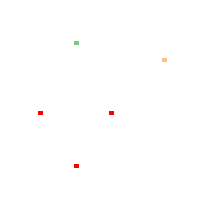 MULTIPOINT ((50 60), (90 60), (70 30)) |
Must be disjoint (mbd) | Input: Point Features Output: MultiPoint | A point must not coincide with other points of its layer. Errors are created when points interserct. |  |  |
Must be disjoint (mbd_wt) Tolerance version | Input: Point Features Output: MultiPoint | A point must not coincide with other points of its layer. |   | 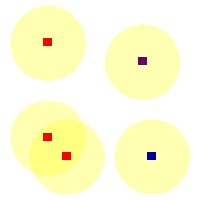 |
| Must not be duplicated (mnbd) | Input: All Output: Same as input | A Geometry must not be spatially equal to another Geometry. (ST_Equals) Note that this method computes topologically equality, not structural or vertex-wise equality | POINT (10 10) POINT (10.08 10) POINT (10 10) | Error POINT (10 10) |
Must not be duplicated (mnbd_wt) Tolerance version | Input: Point Output: Point | A point must not be spatially equal or nearly equal (tolerance) | POINT (10 10) POINT (10.08 10) POINT (12 12) Tolerance 0.1 | Error POINT (10 10) |
Must not have repeated points (mnhrp) | Input: Point Features Output: MultiPoint | A vertex must be captured just once. | MULTIPOINT ((50 50), (90 60), (50 50)) | MULTIPOINT ((50 50)) |
| Rule | Input / Output | Description | Example | |
|---|---|---|---|---|
Must be disjoint with (mbdw) | Input 1: Point Features Input 2: Point Features Output: Point Features | A point must not coincide with other points of another layer. Errors are the original non disjoint points. |  |  |
Must be disjoint with (mbdw_wt) Tolerance version | Input 1: Point Features Input 2: Point Features Output: MultiPoint | A point must not coincide with other points of its layer. Errors consist of the original non disjoint geometries. | 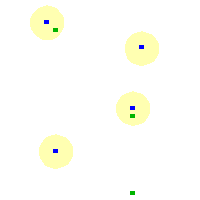  |  |
Must be coincident with (mbcw) | Input 1: Point Features (just 1 point) Input 2: Point Features Output: Point Features | Checks that points of one layer are exactly coincident with points in another layer. | 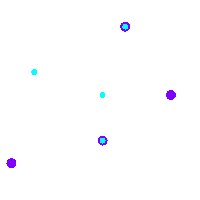 |  |
Must be coincident with (mbcw_wt) Tolerance | Input 1: Point Features (just 1 point) Input 2: Point Features Output: Point Features | Checks that points of one layer are coincident with points in another layer. Points do not need to be exactly coincident, they can be as close together as the tolerance indicates. Errors consist of the disjoint points. | 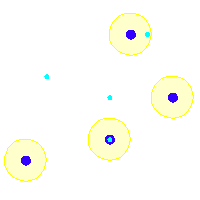  | 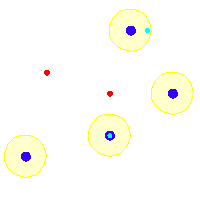 |
| Rule | Input / Output | Description | Example | |
|---|---|---|---|---|
| Must be inside (mbi) | Input 1: Point Features Input 2: Line Features Output: Point Features | A point must be inside a line from another layer. Points can lie at endpoints of a line. |  |  |
| Must be properly inside (mbpi) | Input 1: Point Features Input 2: Line Features Output: Point Features | A point must be properly inside a line from another layer. Points do not lie endpoints of a line. Errors consist of points that do not lie completely in the interior of a line from another layer. |  | 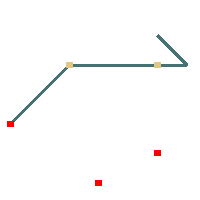 |
| Rule | Input / Output | Description | Example | |
|---|---|---|---|---|
| Must be inside (mbi) | Input 1: Point Features Input 2: Polygon Features Output:Point Features | A point must be inside a polygon from another layer. Points can lie at edges of polygons. | 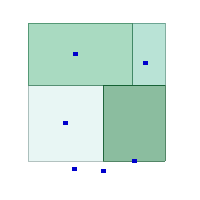 | 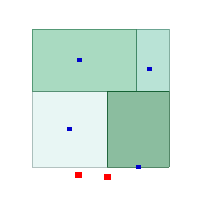 |
| Must be properly inside (mbpi) | Input 1: Point Features Input 2: Polygon Features Output:Point Features | A point must be properly inside of a polygon from another layer. Points do not fall on polygon boundaries. Errors consist of points that do not lie completely in the interior of a polygon. |  | 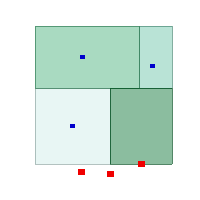 |
Must be covered by boundary of (mbcbbo) | Input 1: Point Features Input 2: Polygon Features Output: Point Features | A point must be covered by the boundary of an area layer. Requires that points lie on edge of polygons. | 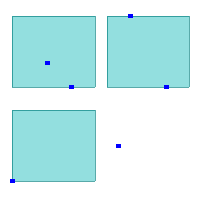 | 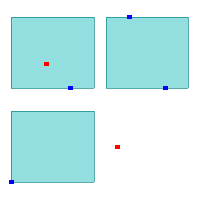 |
| Rule | Input / Output | Description | Example | Errors |
|---|---|---|---|---|
Must be single Part (mbsp) | Input: MultiLineString Output: MultiLineString | Checks that multigeometries have only one part. Any geometry with more than one part is an error. |  MULTILINESTRING ((16 -8, 52 9, 93 -9)) MULTILINESTRING ((15 13, 54 35), (101 12, 63 34)) | 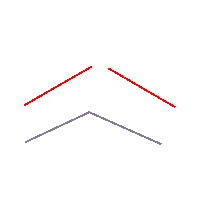 MULTILINESTRING ((15 13, 54 35), (101 12, 63 34)) |
Must not self intersect (mnsi) | Input: Line Features Output: MultiPoint | Checks that lines do not cross or overlap themselves. Errors consist of the points where a line intersects itself. |  | 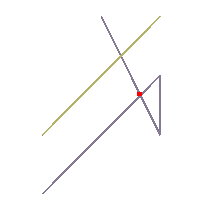 |
Must not intersect or touch interior (mnioti) | Input: Line Features Output: Table without geometry constraint. (Point or LineString) | Checks that lines do not overlap or interserct (except at
endpoints). Errors consist of points if lines intersect, or lines if lines overlap. | 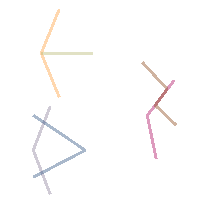 | 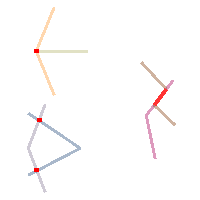 |
Must not touch interior (mnti) | Input: Line Features Output: Point | Checks that an endpoint of a line does not touch another line. Lines can overlap of intersect other lines. |  |  |
Must not intersect (mni) | Input: Line Features Output: Table without geometry constraint. (Point or LineString) | Checks that lines do not intersect. Errors consist of points or lines. |  | 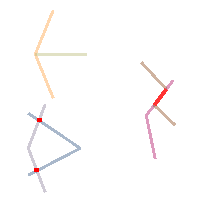 |
Must be disjoint (mbd) | Input: Line Features Output: (Point or LineString geometries) | A line must not have any part in common with other lines in the same layer. Line errors are created where lines overlap. Points errors are created where lines cross or touch each other. | 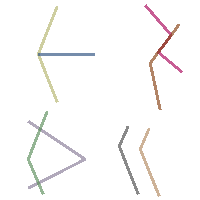 | 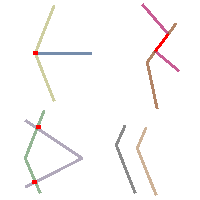 |
Must be disjoint (mbd_wt) Tolerance version | Input: Line Features Output: MultType | A line must not have any part in common with other lines. Errors consist of the original non disjoint geometries. | 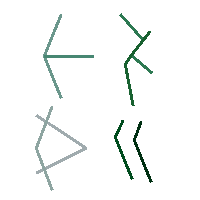 | 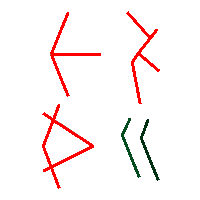 |
| Must not be duplicated (mnbd) | Input: All Output: Same as input | A Geometry must not be spatially equal to another Geometry. (ST_Equals) Note that this method computes topologically equality, not structural or vertex-wise equality | LINESTRING (30 40, 60 40) LINESTRING (30 40, 60 40) LINESTRING (40 50, 60 70) | Error LINESTRING (30 40, 60 40) |
Must not overlap (mno) | Input 1: Line Features Output: MultiLineString | A line must not share its interior with lines of the same layer. Lines can cross or share vertices. Errors consist of the intersection of the interiors with linear dimension. | 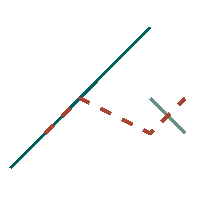 | 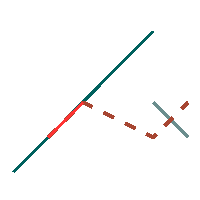 |
Must not have dangles (mnhd) SearchWindow | Input: Line Features Output: Point Features | Every line endpoint must be connected to a line. This rule detects undershoots and overshoots. |  |  |
Must not have dangles (mnhd_wt) Tolerance version | Input: Line Features Output: Point | Every line endpoint must be connected to a line. This
rule detects undershoots and
overshoots. Tolerance | 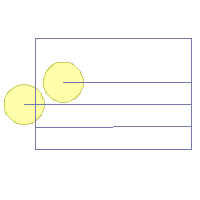  |  |
| Must not have pseudonodes (mnhp) | Input: Line Features Output: Point | Checks that lines connect at least 2 other lines at endpoints. Pseudones consist of nodes with 2 arcs. |  | 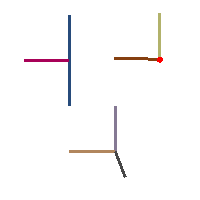 |
Must not have pseudonodes (mnhp_wt) Tolerance version | Input: Line Features Output: Point | Nodes with 2 arcs. Requires that lines connect at al least 2 endpoints. |   |  |
Must not have repeated points (mnhrp) | Input: Line Features Output: MultiPoint | Checks that the vertices of a line are captured just once. | LINESTRING (0 0 15, 10 10 25, 10 10 25, 20 10 35) | MULTIPOINT ((10 10)) |
| Must be connected 2d, with tolerance (mbc2d_wt) | Input: Line Features Output: Point | Checks that lines that are closer than the tolerance distance are connected | 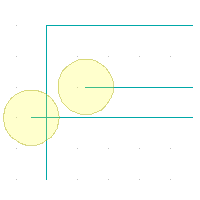  | 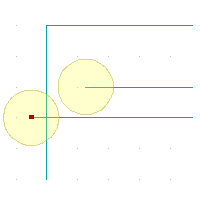 |
| Must be connected 3d, with tolerance (mbc3d_wt) | Input: Line Features Output: Point | Checks that lines that are closer than the tolerance distance are connected vertically | 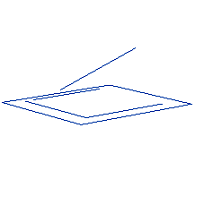 | 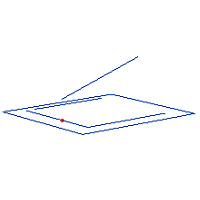 |
| Rule | Input / Output | Description | Example | |
|---|---|---|---|---|
| Must not intersect or touch interior with (mniotiw) | Input 1: Line Features Input 2: Line Features Output: Table without geometry constraint. (Point or LineString) | Checks that lines do not overlap or interserct lines of another layer (except at endpoints) | 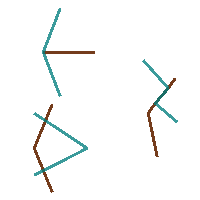 |  |
| Must not intersect with (mniw) | Input 1: Line Features Input 2: Line Features Output: Table without geometry constraint. (Point or LineString) | Checks that Lines do not intersect with lines of another layer. Errors consist of points or lines. |  | 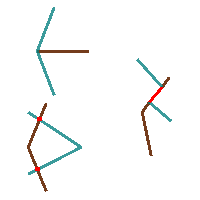 |
| Must not touch interior with (mntiw) | Input 1: Line Features Input 2: Line Features Output: Point | Checks that an endpoint of a line does not touch another line of another layer. Lines can overlap of intersect other lines. Errors consist of points. |  |  |
Must be disjoint with (mbdw) | Input 1: Line Features Input 2: Line Features Output: Table without geometry constraint. (Point or LineString) | A line must not have any part in common with lines of another layer. Line errors are created where lines overlap. Points errors are created where lines cross or touch each other. | 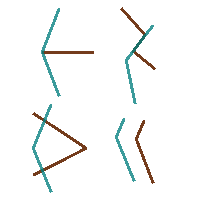 |  |
Must be disjoint with (mbdw_wt) Tolerance version | Input 1: Line Features Input 2: Line Features Output: MultiLineString | A line must not have any part in common with lines of another layer. Stores the original non disjoint geometries. |  |  |
Must not overlap with (mnow) | Input 1: Line Features Input 2: Line Features Output: MultiLineString | A line must not share its interior with lines of another layer. Lines can cross or share vertices. Errors consist of the intersection of the interiors with linear dimension. |  |  |
| Must be inside (mbi) | Input 1: Line Features Input 2: Line Features Output: Line Features | A line must be contained within the endpoints of a line from another layer. |  | 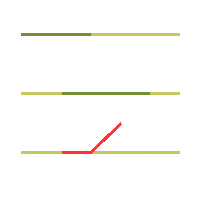 |
| Must be properly inside (mbpi) | Input 1: Line Features Input 2: Line Features Output: Line Features | A line must be properly inside a line from another layer. Errors consists of lines that do not lie completely in the interior of a line from another layer. |  | 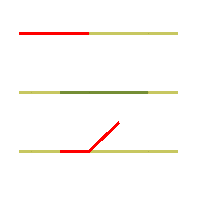 |
| Must be covered by layer (mbcbl) | Input 1: Line Features Input 2: Line Features Output: LineString | Checks that lines from one layer are covered by the lines of another layer. |  |  |
| Must be connected 2d with, with tolerance (mbc2dw_wt) | Input: Line Features Output: Point | Checks that lines from one layer that are closer than the tolerance distance to lines of another layer are connected | 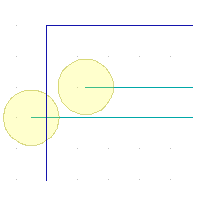  | 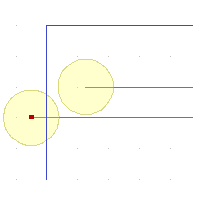 |
| Must be connected 3d with, with tolerance (mbc3dw_wt) | Input: Line Features Output: Point | Checks that lines from one layer that are closer than the tolerance distance to lines of another layer are connected vertically | 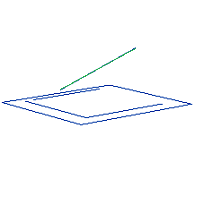 | 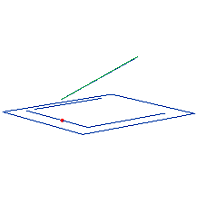 |
Must be cross connected with (mbccw_wt) Tolerance version | Input 1: Line Features Input 2: Line Features Output: Point | Checks that lines from one layer that intersect with lines from another layer, are vertically coincident in the intersection points. Errors consist of the instersection points with different 3d coordinate. | 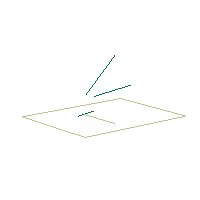 |  |
| Rule | Input / Output | Description | Example | |
|---|---|---|---|---|
| Must be inside (mbi) | Input 1: Line Features Input 2: Polygon Features Output: Line Features (input 1) | A line must be inside a polygon from another layer. | 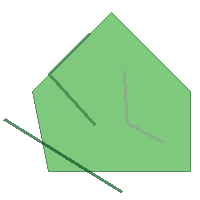 | 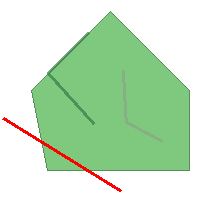 |
| Must be properly inside (mbpi) | Input 1: Line Features Input 2: Polygon Features Output:LineString / MultiLineString | A line must be properly inside a polygon from another layer. Lines do not cross or share boundary with polygon geometries. Errors consists of lines that do not lie completely in the interior of a polygon. |  | 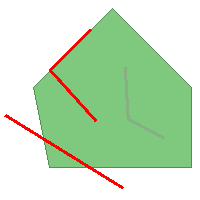 |
Must be covered by layer (mbcbl) | Input 1: Line Features Input 2: Polygon Features Output: LineString | A line must be covered by an area layer. | 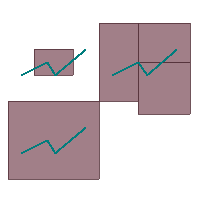 |  |
Must be covered by boundary of layer (mbcbbol) | Input 1: Line Features Input 2: Polygon Features Output: MultiLineString | A line must be covered by the boundary of an area layer. Requires that lines lie on edge of polygons. | 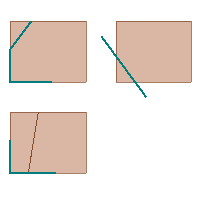 | 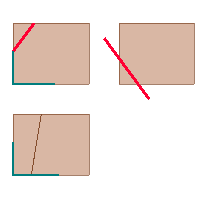 |
Must be covered by boundary of (mbcbbo) | Input 1: Line Features Input 2: Polygon Features Output: Line Features | Checks that Lines are covered by the boundary of polygon features. |  |  |
Must be cross connected with (mbccw_wt) Tolerance version | Input 1: Line Features Input 2: Polygon Features Output: Point | Checks that lines from one layer that intersect with polygons from another layer, are vertically coincident in the intersection points. Errors consist of the instersection points with different 3d coordinate. | 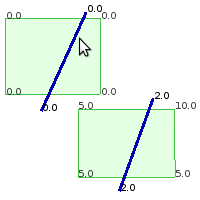 |  |
| Rule | Input / Output | Description | Example | |
|---|---|---|---|---|
Must be single Part (mbsp) | Input: Multipolygon Output: Multipolygon | Checks that multigeometries have only one part. Any geometry with more than one part is an error. | 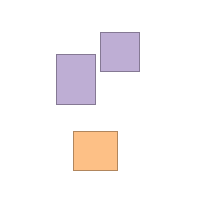 | 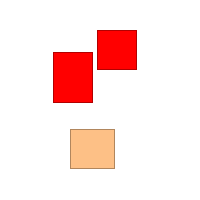 |
Must be valid (mbv) | Input: Polygon Features Output: Polygon Features | Checks that Polygons are well formed. Returns the polygons that are invalid. | 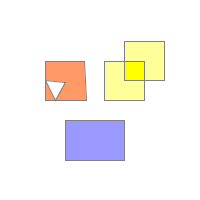 | 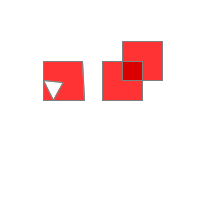 |
Must be disjoint (mbd) | Input: Polygon Features Output: Table without geometry constraint. (Point, LineString or Polygon geometries) | A polygon must not have any part in common with other polygons. Errors are created when polygons interserct. Errors can be polygons, lines or points. |  | 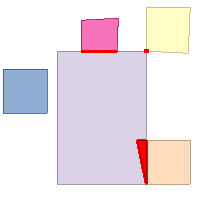 |
Must be disjoint (mbd_wt) Tolerance version | Input: Polygon Features Output: MultiPolygon | A polygon must not have any part in common with other polygons. Errors consist of the original non disjoint geometries. |  | 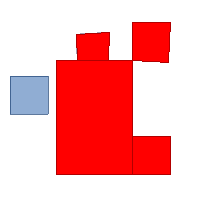 |
| Must not be duplicated (mnbd) | Input: All Output: Same as input | A Geometry must not be spatially equal to another Geometry. (ST_Equals) Note that this method computes topologically equality, not structural or vertex-wise equality | POLYGON ((10 0, 10 40, 40 40, 40 0, 10 0)) POLYGON ((10 0, 10 40, 40 40, 40 0, 10 0)) POLYGON ((50 10, 50 20, 70 20, 70 10, 50 10)) | Error POLYGON ((10 0, 10 40, 40 40, 40 0, 10 0)) |
Must not overlap (mno) | Input: Polygon Features Output: MultiPolygon | A polygon must not share its interior with other polygons. But polygons can share lines or vertices. Errors consist of the intersection of the interiors with dimension 2. | 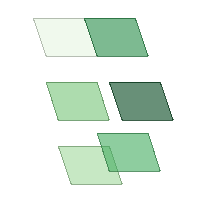 | 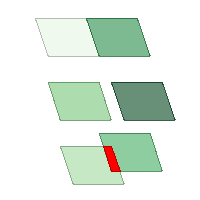 |
Must not have gaps (mnhg) | Input: Polygon Features Output: MultiLineString | Polygons must form a continuous surface, without gaps. Exterior rings are always marked as errors. | 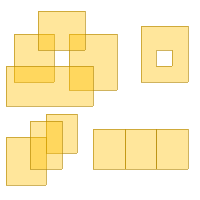 |  |
Must not have repeated points (mnhrp) | Input: Polygon Features Output: MultiPoint | Checks that polygon vertices are captured just once. | POLYGON ((21 15, 21 20, 27 20, 27 20, 27 15, 21 15)) | MULTIPOINT ((27 20)) |
| Rule | Input / Output | Description | Example | |
|---|---|---|---|---|
| Must contain one point (mcop) | Input 1: Polygon Features Input 2: Pointal Output: Polygon Features | Each polygon must have one point inside it. Points outside polygons are not errors. | 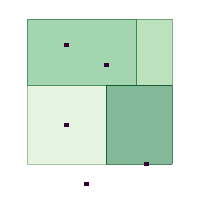 |  |
| Must contain properly one point (mcpop) | Input 1: Polygon Features Input 2: Pointal Output: Polygon Features | Each polygon must have one point inside it. Points outside polygons are not errors. |  | 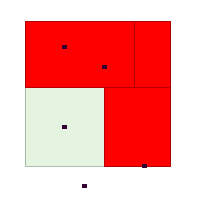 |
| Must contain points (mcp) | Input 1: Polygon Features Input 2: Pointal Output: Polygon Features | Each polygon must have at least one point inside it. Points outside polygons are not errors. |  |  |
| Must contain properly points (mcpp) | Input 1: Polygon Features Input 2: Pointal Output: Polygon Features | Each polygon must have at least one point properly inside it. Points outside polygons are not errors. |  | 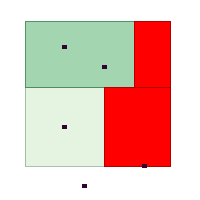 |
| Rule | Input / Output | Description | Example | |
|---|---|---|---|---|
Boundary must be covered by layer (bmbcbl) | Input 1: Polygon Features Input 2: Line Features Output: MultiLineString | Checks that each polygon boundary is covered by lines of another layer. | 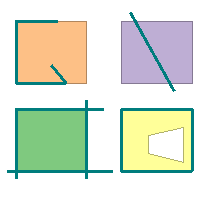 |  |
Must be cross connected with (mbccw_wt) Tolerance version | Input 1: Polygon Features Input 2: Line Features Output: Point | Checks that polygons from one layer that intersect with lines from another layer, are vertically coincident in the intersection points. Errors consist of the instersection points with different 3d coordinate. |  |  |
| Rule | Input / Output | Description | Example | |
|---|---|---|---|---|
Must be disjoint with (mbdw) | Input 1: Polygon Features Input 2: Polygon Features Output:Table without geometry constraint. (Point or LineString) | A polygon must not have any part in common with polygons of another layer. Errors are created when polygons interserct. Errors can be polygons, lines or points. |  |  |
Must be disjoint with (mbdw_wt) Tolerance version | Input 1: Polygon Features Input 2: Polygon Features Output: MultiPolygon | Stores the original non disjoint geometries. |   |  |
Must not overlap with (mnow) | Input 1: Polygon Features Input 2: Polygon Features Output: MultiPolygon | A polygon must not share its interior with polygons of another layer. Polygons can share lines or vertices. Errors consist of the intersection of the interiors with polygonal dimension. | 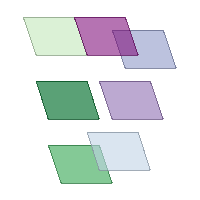 |  |
| Must be inside (mbi) | Input 1: Polygon Features Input 2: Polygon Features Output: Polygon Features (input 1) | A polygon must be inside a polygon from another layer. | 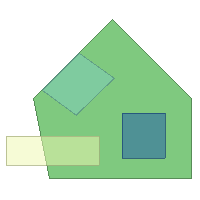 | 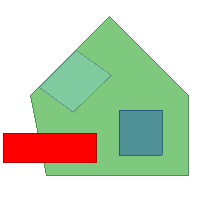 |
| Must be properly inside (mbpi) | Input 1: Polygon Features Input 2: Polygon Features Output: Polygon Features | A polygon must be properly inside a polygon from another layer. Errors consists of polygons that do not lie completely in the interior of a polygon from another layer. |  | 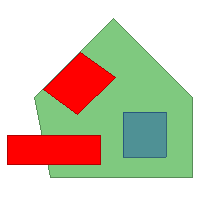 |
| Must be covered by layer (mbcbl) | Input 1: Polygon Features Input 2: Polygon Features Output: Polygon | Checks that a Polygon in a layer is covered by polygons of another layer. |  | 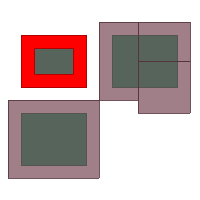 |
Boundary must be covered by boundary of layer (bmbcbbol) | Input 1: Polygon Features Input 2: Polygon Features Output: MultiLineString | Checks that Polygons are covered by the boundary of polygon features of another layer. | 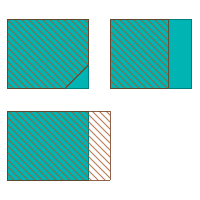 | 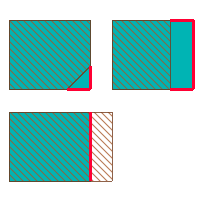 |
Must be cross connected with (mbccw_wt) Tolerance version | Input 1: Polygon Features Input 2: Polygon Features Output: Point | Checks that polygons from one layer that intersect with polygons from another layer, are vertically coincident in the intersection points. Errors consist of the instersection points with different 3d coordinate. |  | 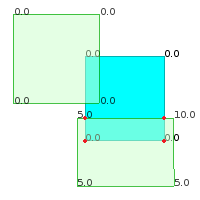 |
